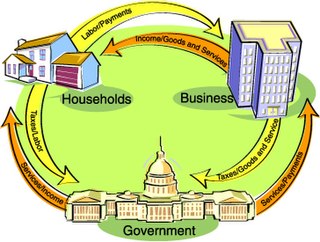
In economics, hyperinflation is very high and typically accelerating inflation. It quickly erodes the real value of the local currency, as the prices of all goods increase. This causes people to minimize their holdings in that currency as they usually switch to more stable foreign currencies, in recent history often the US dollar. Prices typically remain stable in terms of other relatively stable currencies.

In economics, inflation is a general rise in the price level of an economy over a period of time. When the general price level rises, each unit of currency buys fewer goods and services; consequently, inflation reflects a reduction in the purchasing power per unit of money – a loss of real value in the medium of exchange and unit of account within the economy. The opposite of inflation is deflation, a sustained decrease in the general price level of goods and services. The common measure of inflation is the inflation rate, the annualised percentage change in a general price index, usually the consumer price index, over time.
Purchasing Power Parity (PPP) is a measurement of prices in different countries that uses the prices of specific goods to compare the absolute purchasing power of the countries' currencies. In many cases PPP produces an inflation rate that is equal to the price of the basket of goods at one location divided by the price of the basket of goods at a different location. The PPP inflation and exchange rate may differ from the market exchange rate because of poverty, tariffs, and other transaction costs.

International Financial Reporting Standards, commonly called IFRS, are accounting standards issued by the IFRS Foundation and the International Accounting Standards Board (IASB). They constitute a standardised way of describing the company’s financial performance and position so that company financial statements are understandable and comparable across international boundaries. They are particularly relevant for companies with shares or securities listed on a public stock exchange.

In accounting, an economic item's historical cost is the original nominal monetary value of that item. Historical cost accounting involves reporting assets and liabilities at their historical costs, which are not updated for changes in the items' values. Consequently, the amounts reported for these balance sheet items often differ from their current economic or market values.
Purchasing power is the amount of goods and services that can be purchased with a unit of currency. For example, if one had taken one unit of currency to a store in the 1950s, it would have been possible to buy a greater number of items than would be the case today, indicating that the currency had a greater purchasing power in the 1950s. Currency can be either a commodity money, like gold or silver, or fiat money emitted by government sanctioned agencies.
In economics, unit of account is one of the money functions.

Financial accounting is the field of accounting concerned with the summary, analysis and reporting of financial transactions related to a business. This involves the preparation of financial statements available for public use. Stockholders, suppliers, banks, employees, government agencies, business owners, and other stakeholders are examples of people interested in receiving such information for decision making purposes.
In economics, nominal value is measured in terms of money, whereas real value is measured against goods or services. A real value is one which has been adjusted for inflation, enabling comparison of quantities as if the prices of goods had not changed on average. Changes in value in real terms therefore exclude the effect of inflation. In contrast with a real value, a nominal value has not been adjusted for inflation, and so changes in nominal value reflect at least in part the effect of inflation.
Indexation is a technique to adjust income payments by means of a price index, in order to maintain the purchasing power of the public after inflation, while deindexation is the unwinding of indexation.
Chronic inflation is an economic phenomenon occurring when a country experiences high inflation for a prolonged period due to continual increases in the money supply among other things. In countries with chronic inflation, inflation expectations become 'built-in', and it becomes extremely difficult to reduce the inflation rate because the process of reducing inflation by, for example, slowing down the growth rate of the money supply, will often lead to high unemployment until inflationary expectations have adjusted to the new situation.
The Daily Unidade Real de Valor, or URV, was a non-monetary reference currency created in March 1994, as part of the Plano Real in Brazil. It was the most theoretically sophisticated piece of the Plano Real and was based on a previous academic work by Pérsio Arida and André Lara Resende, the "Larida Plan", published in 1984.
Materiality is a concept or convention within auditing and accounting relating to the importance/significance of an amount, transaction, or discrepancy. The objective of an audit of financial statements is to enable the auditor to express an opinion whether the financial statements are prepared, in all material respects, in conformity with an identified financial reporting framework such as Generally Accepted Accounting Principles (GAAP).
When a daily indexed unit of account or Daily Consumer Price Index or monetized daily indexed unit of account is used in contracts or in the Capital Maintenance in Units of Constant Purchasing Power accounting model, deferred payments and constant real value non-monetary items are indexed to the general price level in terms of a Daily Index such that changes in the inflation rate—in the case of monetary items—and the stable measuring unit assumption—in the case of constant real value non-monetary items—have no effect on the real value of these items. Non-indexed units, such as contracts written in nominal currency units and nominal monetary items, incur inflation or deflation risk in the case of monetary items. During all periods of inflation, the debtor pays less in real terms than what both the debtor and creditor agreed at the original time of the contract/sale. On the other hand, in periods of deflation, the debtor pays more in real terms than the original agreed value. The opposite is true for creditors. Contracts and constant real value non-monetary items accounted in daily indexed units of account, Daily CPI or monetized daily indexed units of account incur no inflation or deflation risk, as the real value of payments and outstanding capital amounts remain constant over time while the nominal values are inflation- or deflation-indexed daily.

Constant purchasing power accounting (CPPA) is an accounting model approved by the International Accounting Standards Board (IASB) and the US Financial Accounting Standards Board (FASB) as an alternative to traditional historical cost accounting under hyper-inflationary environments and all other economic environments. Under this IFRS and US GAAP authorized system, financial capital maintenance is always measured in units of constant purchasing power (CPP) in terms of a Daily CPI during low inflation, high inflation, hyperinflation and deflation; i.e., during all possible economic environments. During all economic environments it can also be measured in a monetized daily indexed unit of account or in terms of a daily relatively stable foreign currency parallel rate, particularly during hyperinflation when a government refuses to publish CPI data.

Hyperinflation in Brazil occurred between the first three months of 1990. The monthly inflation rates between January and March 1990 were 71.9%, 71.7% and 81.3% respectively. As accepted by the International Monetary Fund (IMF), hyperinflation is defined as a period of time in which the average price level of goods and services rise by more than 50% a month.

International Accounting Standard 16 Property, Plant and Equipment or IAS 16 is an international financial reporting standard adopted by the International Accounting Standards Board (IASB). It concerns accounting for property, plant and equipment, including recognition, determination of their carrying amounts, and the depreciation charges and impairment losses to be recognised in relation to them.

International Accounting Standard 10 Events after the Reporting Period or IAS 10 is an international financial reporting standard adopted by the International Accounting Standards Board (IASB). It contains requirements for when events between the end of the reporting period and the date on which the financial statements are authorised for issue should be reflected in the financial statements.

International Accounting Standard 8 Accounting Policies, Changes in Accounting Estimates and Errors or IAS 8 is an international financial reporting standard (IFRS) adopted by the International Accounting Standards Board (IASB). It prescribes the criteria for selecting and changing accounting policies, accounting for changes in estimates and reflecting corrections of prior period errors.

IFRS 16 is an International Financial Reporting Standard (IFRS) promulgated by the International Accounting Standards Board (IASB) providing guidance on accounting for leases. IFRS 16 was issued in January 2016 and is effective for most companies that report under IFRS since 1 January 2019. Upon becoming effective, it replaced the earlier leasing standard, IAS 17.